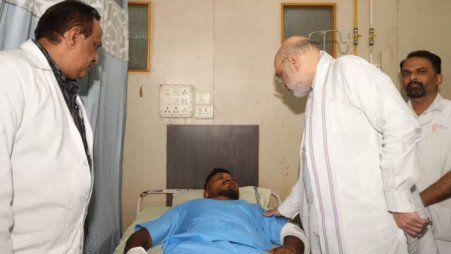Table of Contents
TogglePassenger in Seat 11A Survives Air India Crash: Is It Really the Safest Seat on a Plane?
A tragic Air India plane crash in Ahmedabad shocked the nation and the world, leaving behind a grim trail of wreckage and loss. Yet amid the devastation, a single spark of hope emerged — one man, Ramesh Viswashkumar, miraculously walked out of the burning wreckage alive. What astonished people even more was his seat number — 11A, located right next to an emergency exit. His survival has sparked a global debate and renewed curiosity about one critical question: Is 11A the safest seat on a plane?
As aviation investigators dig deeper into the cause of the crash, public attention has shifted to the layout of the aircraft and the role a specific seat might play in surviving an accident. Is it possible that 11A — or any seat in particular — offers a statistically safer chance of survival? Or was Viswashkumar’s escape simply the result of a fortunate combination of circumstances?Passenger
The Crash: A Brief Overview
On a cloudy morning in early June 2025, the Air India Boeing 787 Dreamliner was en route from Mumbai to Ahmedabad when it crashed near the outskirts of the city just moments before landing. According to initial reports, the aircraft suffered a technical failure during descent, leading to an uncontrollable drop and subsequent impact with an under-construction building near the airport’s boundary wall.Passenger
The crash site was horrific — flames, thick black smoke, and mangled aircraft parts scattered across a large area. Emergency services rushed to the scene, but it was already too late for most on board. Out of the 189 passengers and crew, only one survived: Ramesh Viswashkumar, seated in 11A.Passenger
A Miracle Seat or Just Sheer Luck?
Viswashkumar’s survival has led many to speculate about the possible safety benefits of his seating location. According to his own statement, he was seated next to an emergency exit, which turned out to be the only accessible escape point after the crash.Passenger
“I was lucky to be sitting right beside the door,” said Viswashkumar, speaking from a hospital bed. “When the plane hit, everything shook, and people screamed. But somehow, the wall near my side didn’t collapse. I saw the emergency door still intact, so I kicked it and crawled out.”Passenger
On the other side of the aircraft, where the opposite exit was located, the building’s wall had caved in, completely blocking access. This meant that even passengers who might have been conscious or uninjured had no route to escape. Viswashkumar’s seat happened to be in the only section where the structure around him didn’t collapse — a fortunate alignment of position, aircraft design, and external conditions.
The Seat 11A Theory: What Does Aviation Science Say?
While Viswashkumar’s escape has led to theories that seat 11A is somehow inherently safer, aviation experts urge the public not to draw hasty conclusions.
“There’s no guaranteed safe seat in any aircraft,” said Ron Bartsch, an internationally respected aviation safety consultant. “In this case, 11A happened to be adjacent to a functioning emergency exit, and the impact dynamics of the crash allowed that area to remain accessible.”Passenger
Aircraft seating varies by model, and what might be seat 11A in one aircraft could be in a completely different section in another. In some planes, it might be near an emergency exit, while in others, it could be located mid-cabin without direct access to any exits.Passenger
Also, Boeing 787 Dreamliners often feature different seat configurations based on airline preference — ranging from business-heavy layouts to dense economy configurations. The presence of multiple exits and aisle arrangements means no seat maintains a consistent safety advantage across aircraft models.Passenger
Aisle vs. Window vs. Rear: What the Data Says
The U.S. Federal Aviation Administration (FAA) and other safety organizations have analyzed numerous accidents over the decades to identify any patterns in passenger survival rates based on seating positions. While results vary from crash to crash, a few patterns have emerged:
-
Rear of the Plane: A 2007 study by Popular Mechanics analyzed data from 20 crashes and concluded that passengers seated at the rear had a 40% higher survival rate than those at the front.
-
Aisle Seats: These offer quicker access to exits but also expose passengers to higher risks of injury from falling baggage or being struck by debris during turbulence.
-
Window Seats: These offer better protection from aisle congestion but might delay evacuation if the person seated next to the aisle is injured or panicking.
However, no consistent rule can be applied. Factors like impact angle, fire location, exit blockage, weather conditions, and post-crash fire spread all drastically affect survival chances.
Iran Claims Downing of Two Israeli F-35 Jets and Captures Female Pilot Alive
Read This Articals
The Real Key: Preparedness and Calmness
According to multiple aviation safety bodies, including the International Civil Aviation Organization (ICAO) and European Union Aviation Safety Agency (EASA), the real determinants of survival often come down to passenger behavior and crew performance, not seat location.
“You can sit next to the exit and still not make it out if you panic or don’t know how to open the door,” said Ayesha Mir, a flight safety trainer with over 15 years of experience. “Survival often comes down to seconds. If you’re alert and follow instructions, your chances go up significantly.”
Some recommended tips include:
-
Always listen to the safety briefing.
-
Know where your nearest two exits are.
-
Count the number of rows between you and the exit.
-
Wear secure footwear.
-
Don’t block the aisle with bags or loose items.
-
Remain calm and follow crew instructions.
Lessons from Other Plane Crashes
A number of past aviation incidents demonstrate how factors beyond seat location influence survival:
Japan Airlines Flight 516 (2024)
In this Tokyo-based accident, the aircraft caught fire shortly after landing. However, all 367 passengers onboard survived. The reason? Swift evacuation and well-trained crew. Passengers followed instructions, didn’t block exits with luggage, and used emergency slides within 90 seconds.
Asiana Airlines Flight 214 (2013)
This crash occurred during landing in San Francisco. Of the 307 people onboard, 304 survived. Most survivors were seated in the middle to rear sections of the aircraft, backing the theory that rear seats might offer better survival odds in certain crashes.
British Airtours Flight 28M (1985)
In this fire accident on the runway, passengers in the forward cabin had a much lower survival rate due to blocked exits and rapid smoke inhalation, not the crash impact itself.
These examples reaffirm the idea that seat location alone is not enough. The success of an evacuation depends on factors like fire spread, structural integrity post-crash, and evacuation route availability.
Are Planes Getting Safer?
Despite the emotional weight of the Air India tragedy, it’s important to recognize that aviation has never been safer than it is today.
-
Modern aircraft materials are flame-retardant and more crash-resistant.
-
Evacuation slides deploy faster and are more stable.
-
Cabin lighting systems now include floor-level LED paths for guidance in smoke.
-
Pilot training has become more advanced, with better simulation scenarios.
-
Air traffic control systems help prevent mid-air and runway collisions.
According to the International Air Transport Association (IATA), the global jet accident rate in 2024 was 0.34 per million flights, which is equivalent to one accident every 2.9 million flights.
Conclusion: The Mystery of 11A
While it’s tempting to label seat 11A as the “safest seat” due to the survival of Ramesh Viswashkumar in the tragic Air India crash, experts strongly caution against drawing such conclusions.
Viswashkumar’s survival was a combination of favorable crash dynamics, proximity to an accessible emergency exit, and his calm and decisive actions. While the incident offers valuable insights, it does not establish any scientific basis for assigning safety to one seat over another.
The true takeaway is not about which seat to book on your next flight but about how well-prepared you are. Paying attention to the safety briefing, staying aware of your surroundings, and remaining composed during emergencies are far more effective survival tools than any specific seat number.
Frequently Asked Questions (FAQs)
Q1: Is seat 11A always near the emergency exit?
Not necessarily. Seat layouts vary across aircraft types and airlines. In some configurations, 11A might be near an exit, while in others, it might be mid-cabin or even farther away.Passenger
Q2: Are rear seats safer in plane crashes?
Some studies suggest rear seats have slightly higher survival rates in certain crash types, but this is not always true. Each crash has unique dynamics.
Q3: What is the safest way to fly?
Flying with reputable airlines, listening to safety briefings, keeping your seatbelt fastened, and remaining calm in emergencies significantly improve your chances of safety.
Q4: How quickly should you evacuate a plane?
Experts say the ideal window is within 90 seconds, as fires and smoke spread rapidly after a crash or accident.
Q5: Is flying still the safest mode of transport?
Yes. Statistically, commercial air travel remains the safest mode of transportation, far surpassing cars, trains, or buses in terms of fatalities per mile traveled.




